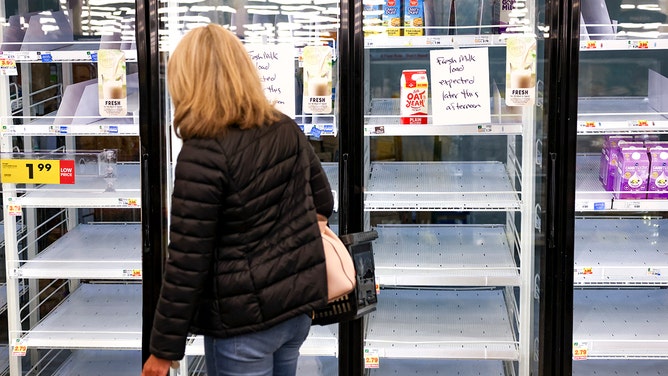Why do people buy all the milk and bread before snowstorms? Here's why
While no one knows what this winter will bring, one thing is for certain – the bread and milk aisles are a barren wasteland when the snowstorm hits
Why do people purchase bread, milk, toilet paper before a big storm?
Professor of Public Health at the University of Utah Kimberly Shoaf shares insight with FOX Weather.
It’s not the end of the world. Or is it?
While no one knows what this winter will bring, one thing is for certain – the bread and milk aisles are a barren wasteland when the snowstorm hits. But why do we turn to stockpile these perishables when there’s a winter storm on the horizon?
"When you think about sending somebody to the store, the first thing in your mind is, ‘do we have milk, bread and eggs?’" said Dr. Kimberley Shoaf, a professor of public health at the University of Utah.
They are the basis of our diet and how we cook in the United States.

Grocery delivery shopper Courtney Fox of Newark, Calif., stands in the empty bread aisle as she searches for items for three separate Instacart orders at a Safeway supermarket in Palo Alto, Calif. Tuesday, March 17, 2020.
(Jessica Christian / Getty Images)
For anyone who grew up in an Italian household, they will tell you that a routine trip to the grocery store will carry you through a few months of blizzards.
WHAT MAKES A BLIZZARD DIFFERENT FROM AN ORDINARY SNOWSTORM?
"We laugh when we see people running to the stores to get bread and milk. We have a refrigerator in every room," New Jersey comedian Vic DiBitetto said.
In 2013, bread and milk made DiBitetto a viral sensation. His 28-second YouTube clip helped skyrocket his career.
"The amount of actual views across all social media platforms and on digital and terrestrial outlets is impossible to determine now," DiBitetto said. "It’s in the billions. Not kidding!"
DiBitetto believes his video was such a success because people could relate. He also credits the idea that we were taught to run to the store whenever anybody mentioned the four-letter word – snow.
"Gotta’ get the bread and milk," DiBitetto jokes. "Meanwhile, if the storm lasts too long, now all you have is cheese and penicillin."
However, they are not shelf-stable.
"The reason why you see them gone is that they’re perishable, and grocery stores only keep a certain amount of that on stock because they go bad," Shoaf said.
7 THINGS TO KNOW ABOUT ICE STORMS
They’ve got a shelf life, and grocery stores only have about a week’s worth of typical shopping experiences available to stock those shelves.
"So if everybody goes out on Friday instead of Monday through Saturday to buy those things, those shelves are going to empty, and they don’t get their next round of supplies until the next week," Shoaf explains.
Items like bread and milk empty faster because stores only have so much of that available.

A woman browses a nearly empty milk section at a King Soopers grocery store ahead of a winter storm on March 12, 2021 in Golden, Colorado.
(Michael Ciaglo / Getty Images)
Shoaf said there is also some self-fulfilling prophecy.
Admit it; we’ve all done it one point. You see that the shelves are empty and say, "I should have gone earlier. I should have been the first one to get it."
But in all actuality, it makes very little sense to fill the refrigerator with perishable items if you’re expecting your power to go out.
"It makes much more sense to be prepared in advance," Shoaf said. "I don’t think I have ever gone out and bought milk and eggs and bread in preparation for something that’s going to happen this week or next week."
DON'T LEAVE ANY OF THESE ITEMS IN YOUR CAR THIS WINTER
That’s because she has items like shelf-stable milk, flour, yeast, and dried eggs in her pantry.
"I’ve got those things in advance, and I have shelf-stable versions of these things available that I can use in an emergency," Shoaf said. "You should just be making sure that you’ve got everything that you need to stay safe."
Prepare yourself two weeks out
Shoaf agrees that there is undoubtedly psychology around stockpiling.
Did everybody need five of those oversized packages of toilet paper at the beginning of the pandemic?
"It’s sort of a mob mentality," Shoaf said. "If the mob is running and getting toilet paper, running and buying bread and milk, it might be more of a fear of missing out. 'But what if I really do need that, and I don’t have it?'"
In general, it’s best if people have two weeks' worth of shelf-stable things like canned and dry foods.
7 WAYS TO PROTECT YOUR PETS DURING THE WINTER
"Think about what you eat for two weeks and think about how you can make those meals without using any perishable foods," Shoaf said.
In the event of a winter storm, the American Red Cross encourages having two emergency preparedness kits: One to keep at home to sustain your family for two weeks and a smaller, more easily transportable kit, with a three-day stock of supplies that can be stored in your vehicle or in an easily-accessible location for evacuations.
"In regards to water, we suggest one gallon per person, per day. For food, we suggest non-perishable, easy-to-prepare items that don’t require access to electricity to open or consume," said Stephanie Fox with the American Red Cross National Headquarters.
When packing your kits, Fox said it’s also essential to consider all members of the family. This includes those who may have special dietary needs, food allergies and even your pets.
Bottom line: prepare yourself two weeks out. And don’t rush to the store last minute for milk and bread.
